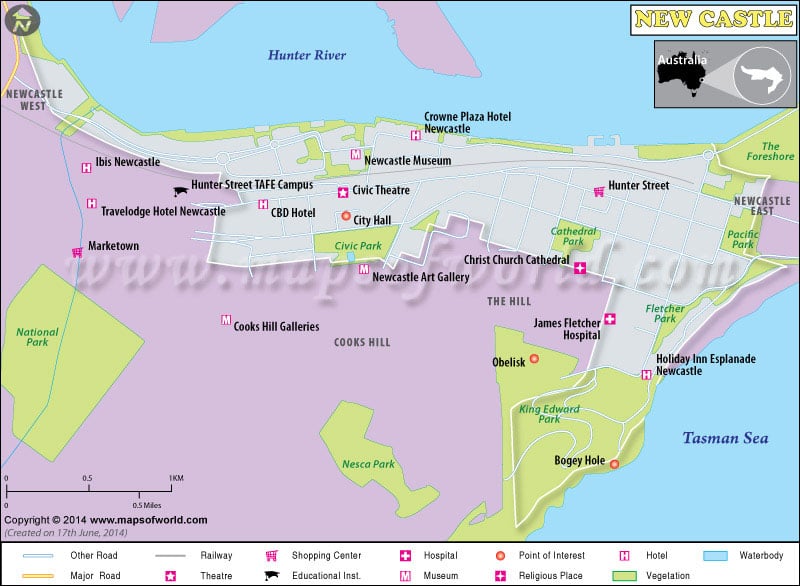Attractions in Newcastle |
|
|---|---|
| Fort Scratchley | Dudley Beach |
| Blackbutt Reserve | Newcastle Ocean Baths |
| Newcastle Museum | Foreshore Park |
| Christ Church Cathedral | Horseshoe Beach |
| Nobby’s Beach | Australian Shark & Ray Centre |
About
Newcastle, Australia is a seaside town north of Sydney, home to Australia’s oldest seaport and the largest coal exporting harbor in the world. Newcastle is an industrial city built by convicts and coal workers. Its major industries have been coal, steelworks, steamships, and military. The industrial parts of the city contrasts its natural settings, against the beauty of the ocean and river. Newcastle is now a laid-back surfing and university town, with the University of Newcastle, and it is also home of the National Stock Exchange of Australia.
Geography
Newcastle is located along the coast in New South Wales, north of Sydney. The city lies along the southern bank of the Hunter River, flowing into Fullerton Cove and its mouth emptying into the ocean at the Newcastle Harbor. The city is situated among beaches and mountains, while near the river are swamps, wetlands, sand dunes, and a green belt. Other geographic features nearby include the Blackbutt Reserve with a rainforest trail and bushlands, the nearby Barrington Tops National Park with its rivers and rainforests, and Lake Macquarie.
How to get there
Newcastle has its own small airport, Newcastle Airport in Williamtown, but it is a regional airport with limited domestic service. However, Newcastle is about 162 kilometers (101 miles) from Sydney, where Sydney (Kingsford-Smith) Airport is a major international airport and the busiest in the country. From there, visitors to Newcastle can reach the city by car, bus, or train. Trains between Sydney and Newcastle depart frequently and take around 3 hours, arriving at Broadmeadow or Newcastle Station.
When to visit
Newcastle enjoys warm summers and mild winters (note that seasons are opposite those in the Northern Hemisphere). The city’s rainy season is from February to June, with the highest average rainfall in March. Several festivals are hosted in Newcastle each year, including the This is Not Art festival in October, Newcastle Jazz Festival in August, Newcastle Regional Show in March, and July’s Shoot Out 24 Hour Filmmaking Festival.
What to see
For most visitors to Newcastle, the beaches are the top attraction, with Nobby’s Beach and Newcastle Beach as two of its most popular. Nobby’s Head at the entrance to the harbor was once Coal Island, but is now connected to the mainland and features a lighthouse. Nobby’s Beach is a popular surf spot for beginners and has regular lifeguard service year-round. Other beaches include Dudley, Merewether, and Horseshoe Beach.
First opened in 1922, the Newcastle Ocean Baths are a historic landmark and still functioning swimming area, its pools filled by the ocean where visitors can swim or soak. The facilities include an art deco pavilion, changing rooms, canoes, and lap pools. The baths are especially convenient when the beaches are closed for rough surf conditions.
At Stockton Beach, visitors will see the shipwreck of the MV Sygna. The ship ran aground in 1974 and its wreckage remains along the shores providing an interesting exploration destination or backdrop for photos. Fort Scratchley is a historic fort that was used during World War II to defend against Japanese attacks. It now houses the Maritime and Military Museum, offers tunnel tours on which guides explain the fort’s history. The fort is also great for scenic vistas of the ocean from its higher elevation above the harbor.
The Christ Church Cathedral is an architectural site in the city center, which first opened in 1818 and has had considerable changes and growth since then, with the addition of its tower and bells in 1979. The church is remarkable for having survived the Newcastle earthquake that devastated much of the city in 1989.
Other places to stop by are the city hall, the art deco University House, the Central Business District, which features Victorian terrace houses and other historical architecture, and Darby Street for shopping.
Where to stay
Hotel accommodations in Newcastle include the Newcastle Backpacker’s hostel, Backpackers by the Beach, Novotel, and Mercure on the lower end, Hotel Ibis and Sovereign Inn for average rates, and the art deco Clarendon Hotel, Boulevard on Beaumont, and Noah’s on the Beach on the higher end. For a stay in a bed and breakfast, options include Ashiana B&B and Riverview Gardens B&B.
